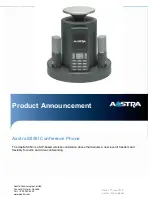
136/142
This device complies with Part 15 of the FCC Rules. Operation is subject to the following two conditions:
(1) this device may not cause harmful interference, and (2) this device must accept any interference
received, including interference that may cause undesired operation.
Statement according to FCC part 15.21:
Modifications not expressly approved by this company could void the user's authority to operate the
equipment.
Health and Safety Information FCC
This EUT has been shown to be capable of compliance for localized specific absorption rate (SAR) for
uncontrolled environment /general population exposure limits specified in ANSI/IEEE Std. C95.1-1992
and had been tested in accordance with the measurement procedures specified in FCC/OET Bulletin 65
Supplement C (2001) and IEEE Std. 1528-2003 Ministry of Health (Canada), Safety Code 6. The
standards include a substantial safety margin designed to assure the safety of all persons, regardless of
age and health. The exposure standard for wireless mobile phones employs a unit of measurement
known as the Specific Absorption Rate, or SAR.
The SAR limit set by the FCC is 1.6 W/kg *.
* In the U.S. and Canada, the SAR limit for mobile phones used by the public is 1.6 watts/kg (W/kg)
averaged over one gram of tissue. The standard incorporates a substantial margin of safety to give
additional protection for the public and to account for any variations in.
***This device contains 1800 MHz DCS and 900 MHZ EGSM functions that are not operational in
U.S. Territories; this filing is applicable 850 MHz GSM 1900 MHz PCS operations
.
FCC HEARING-AID COMPATIBILITY REGULATIONS
FOR WIRELESS DEVICES
FCC ID: JYCC8
2
0
Trade Name/Model(s): AT&T/
C8
2
0
FCC Classification: Licensed Portable Transmitter Held to Ear (PCE)
FCC Rule Part(s): §20.19
HAC Standard: ANSI PC63.19-2005 D3.6
On July 10, 2003, the U.S. Federal Communications Commission (FCC) Report and Order in WT Docket 01-
309 modified the exception of wireless phones under the Hearing Aid Compatibility Act of 1988 (HAC Act) to
require digital wireless phones be compatible with hearing-aids. The intent of the HAC Act is to ensure
reasonable access to telecommunications services for persons with hearing disabilities.
While some wireless phones are used near some hearing devices (hearing aids and cochlear implants),
users may detect a buzzing, humming, or whining noise. Some hearing devices are more immune than
others to this interference noise, and phones also vary in the amount of interference they generate.
The wireless telephone industry has developed a rating system for wireless phones, to assist hearing device
users find phones that may be compatible with their hearing devices. Not all phones have been rated.
Phones that are rated have the rating on their box or a label located on the box.
The ratings are not guarantees. Results will vary depending on the user’s hearing device and hearing loss. If
your hearing device happens to be vulnerable to interference, you may not be able to use a rated phone
successfully. Trying out the phone with your hearing device is the best way to evaluate it for your personal
needs.








































